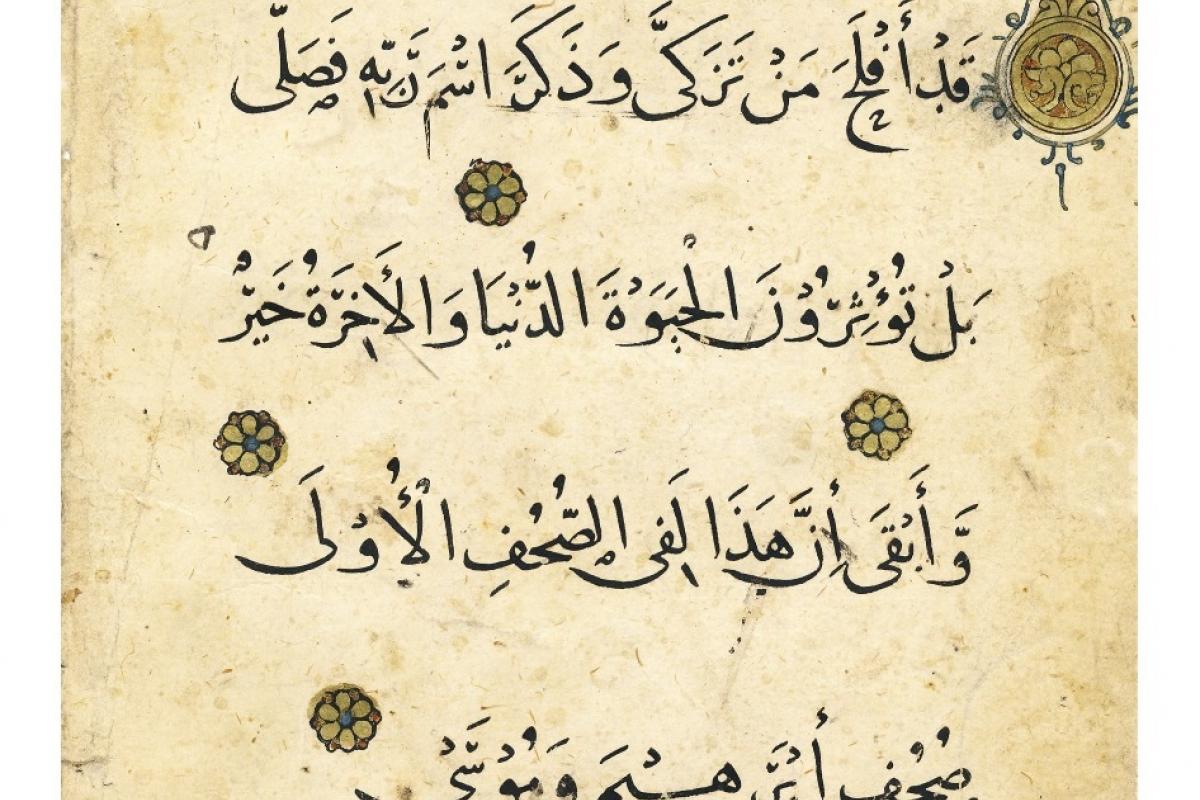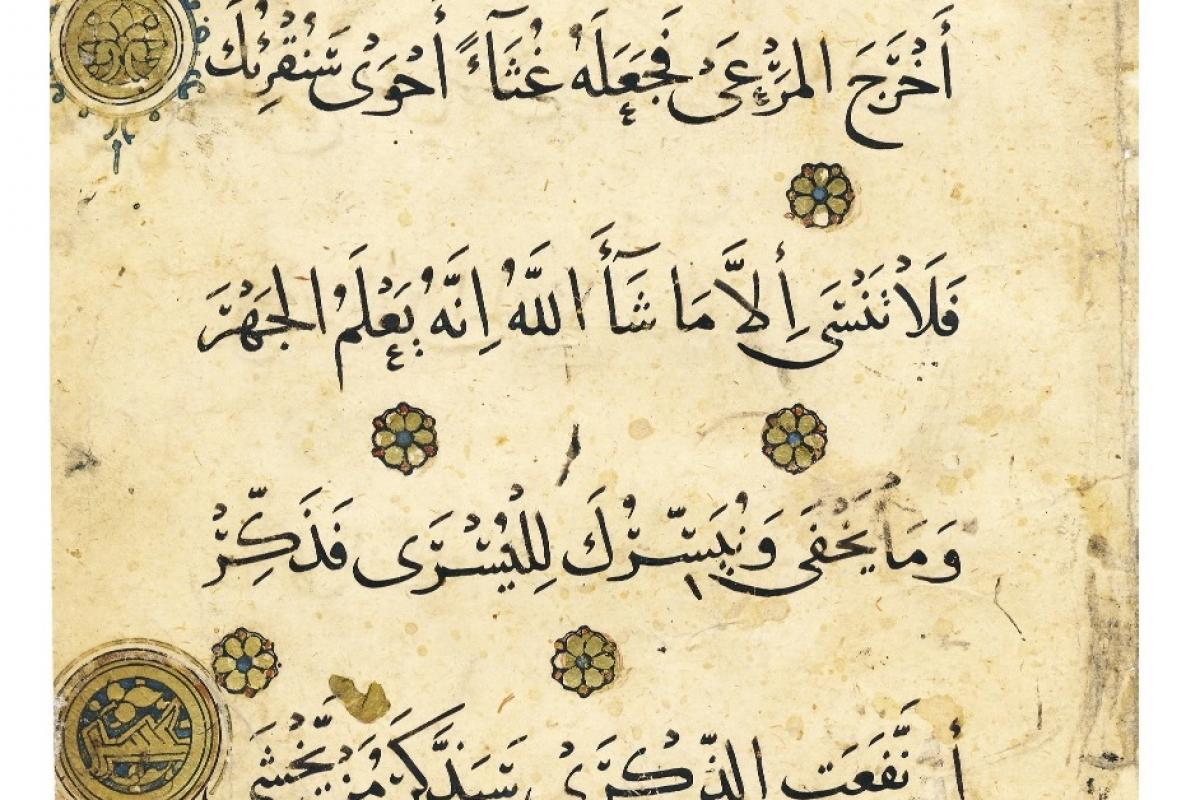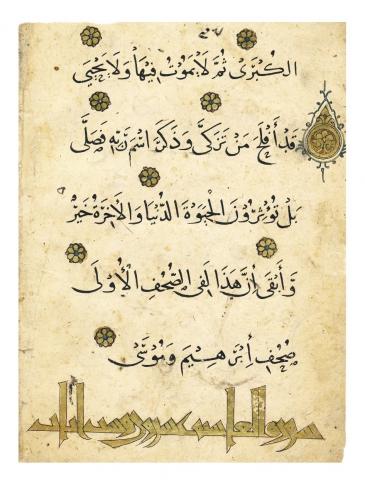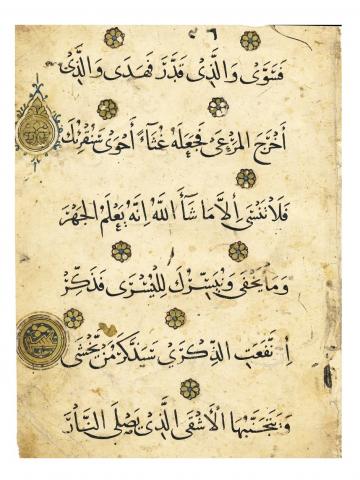Mamluk Qur'an Leaf
Abu Bakr (known as Sandal)
Islamic, ca. 1300-1310 (700-710 AH)
Cairo, Egypt
Leaf with Surah 87, al-'A'la, verses 3-12 (verso), verses 13-19 (recto)
Text in Naskhi or Thuluth script and headings in Kufic script.
height 19.4 cm | width 14.2 cm
Portland State University Library Special Collections, Mss 37
----------
Normandie Holmes, Part of PSU's Gift of the Word Exhibit, Spring 2012
The illuminator Sandal designed this fourteenth-century Qur'an leaf in compliance with a system of religiously-inspired geometric relationships that structured the work of Qur'an copyists. Adherence to these precise ratios for page layout, script and ornamentation, and emphasis on perfect calligraphy, was a sign of inward spirituality and cosmological orderliness.[1] Within these guidelines, however, individual illuminators or their students produced unique Qur'ans, often by commission. They are identifiable in the details of lavish ornamentation of frontispieces, end pieces and panels, but also by the smaller, but no less distinctive, illuminated devices used for verse markers, marginal rubrics and chapter, or Surah, headings. The devices appearing on this leaf permit an attribution to Sandal's atelier in Cairo, as similar illuminations are found on Qur'an pages located in the British Library and the Chester Beatty Library that are attributable by inscription to Sandal.[2]
The small, golden rosettes marking single verses, the larger, teardrop-shaped, fifth-verse markers, and an even larger tenth-verse roundel on the recto side, all have the precise, formulaic size relationships typical of Sandal Qur'ans. The internal decoration is floral or vegetal, and the tenth- verse roundels generally, as here, contain the Arabic word for ten, 'ashar. Use of gold and blue paint, with touches of red, is typical of Qur'ans of this period.[3]
Almost all Mamluk Qur'an pages have an odd number of lines,[4] but the recto side of this leaf has six. There is also a mismatch in the count of single verses in relation to the fifth- and tenth-verse markers. These puzzling discrepancies can be resolved by a text comparison. Referring to Surah 87, it is evident that one and a half verses are not shown here but may have appeared on a previous page. However, lack of traditional margins and a fragment of text at the top of the recto side indicate possible cropping of this leaf. Cropping would explain both the verse marker and line count oddities.
Sandal, or perhaps a collaborating calligrapher, chose naskh script for this leaf. It was the most common copyist script, not limited by convention to Qur'an copies, but also used for government and commercial documents.[5] It was easy to write, even though the copyist had to maintain both a geometrically determined spacing between letters and words and a set proportion of letter size to that of the most important letter alif.[6] This style was suitable for the small, portable Qur'ans of this period. With this fine black naksh, Sandal often used golden surah headings in condensed ornamental kufic script[7] as shown at the bottom of the verso side at the end of the surah, giving chapter title, number of verses and text derivation. A thin black outline emphasizes the solid structure of this script. Kufic script is also used in the tenth-verse roundel forming a visual and informational tie with the surah heading.
Little is known about Sandal, also known as Abu Bakr. The form and meaning of his name implies he was a slave or eunuch[8] but the quality and quantity of his attributed work and the prevalence of his atelier, even after the probable date of his death, indicate that he had influential patronage and was well regarded.[9] Sandal's Qur'ans were commissioned by Mamluks, originally military slaves, who became successful rulers in thirteenth-century Egypt and Syria and viewed traditional art and religion as stabilizing forces.[10] Such patrons would have respected Sandal's geometric precision, and also admired his distinctive designs, lavish ornamentation and golden accents as a sign of Mamluk wealth and status.
Notes:
[1] Martin Lings and Yasin Hamid Safadi, The Qur'an (London: World of Islam Festival Publishing Company Ltd, 1976), 15.
[2] David James, Qur'ans of the Mamluks (New York: Thames and Hudson, 1988), 40, 48.
[3] Marcus Fraser, Geometry in Gold (London: Sam Fogg, 2005), 10-15.
[4] James, Qur'ans of the Mamluks, 48.
[5] Annemarie Schimmel, Calligraphy and Islamic Culture (New York: New York University Press, 1984), 23.
[6] Abdelkebir Khatibi and Mohammed Sijelmassi, The Splendour of Islamic Calligraphy (New York: Thames and Hudson, 1996), 46-47.
[7] James, Qur'ans of the Mamluks, 58.
[8] James, Qur'ans of the Mamluks, 47.
[9] David James, The Master Scribes (London: Nour Foundation, 1992), 150.
[10] James, Qur'ans of the Mamluks, 27-30.
----------
STUDY GUIDE
Rachel R. Correll, Sophomore Inquiry Menor Session Project, Spring 2012
The Object
This is one leaf from a fourteenth-century Qur'an manuscript and includes eighteen verses from chapters (or Suwar) 87 and 88. It is made of paper, measures 19.4 by 14.2 cm, and includes text in black ink and ornamentation with gold leaf. Muslims believe the Qur'an contains text that was first revealed to the prophet Muhammad by the angel Gabriel from 610-632 CE. The verses contained in the Qur'an, therefore, are direct words of Allah (God), and are thus treated as sacred. It was made in Cairo, likely in the workshop of Sandal, a famous illuminator of the fourteenth century, and was commissioned by a Mamluk. Mamluks were at first military slaves of the Islamic rulers (the caliphs/sultans) in Egypt and Syria, but a Mamluk commander in chief became sultan after the death of a Muslim sultan in 1250. The Mamluk dynasty ruled Egypt from 1250 to 1570 CE and they treasured the traditional art and religion of the Muslims. This page displays the importance of structure and ratios in a Qur'an manuscript that were signals of inward spirituality and order of the cosmos.
The Text
The Arabic text (read right to left) is written in Naskh, which was a cursive script commonly used in Qur'anic manuscripts from the fourteenth century forward as it was easier to read and be written as a result of its fluid lines. The gold line of text at the bottom of the verso (the back) of the leaf is written in Kufic script and is the chapter heading for Surah 88: "The Overwhelming." This script is more condensed and angular and thus anchors to the page more strongly than the Naskh script. It draws more attention, especially with the thin black lines that outline the gold letters. The content of the verses on this leaf from Surah 87 ("The Most High") focus on the creations of Allah and rewards for believers who share the Holy Word. Surah 88 emphasizes the powers of Allah and the consequences for nonbelievers.
Ornamentation
Islam holds that the depiction of human form in a religious setting is a type of idolatry. For that reason, no images of objects or figures are allowed in Qur'ans and thus the ornamentation is very elaborate as it is the prime source of illumination in the manuscripts. All the ornamentation on this leaf are verse markers, used by the reader of the Qur'an to quickly find the beginnings of verses. The smaller gold rosettes, with highlights in green ink, are single-verse markers. There are two examples of fifth-verse markers, one on each side of the leaf, which are tear-drop shaped medallions also with plantlike details. On the recto (or front) of the leaf is the tenth-verse marker. This one includes the Arabic word for ten ('ashara) written in Kufic script in the center of the marker.
Source: Normandie Holmes, "Mamluk Qur'an," The Gift of the Word, catalog, Spring 2012 exhibition, Portland State University Millar Library Special Collections.
Inquiry
Examine the two types of script used in this example of the Qur'an. What are the characteristics of the Naskh script of the main text that makes it more readable than the Kufic script of the chapter heading? What do you think are some of the benefits of using verse markers in the margins and between the lines of text? As the Qur'an is considered to be the direct transcription of the words of Allah himself, why do you think it would be important to make the calligraphy and embellishments as perfect as possible? How do you think the owner would have utilized the Qur'an this leaf came from? Do you think he would have carried it around with him?"




